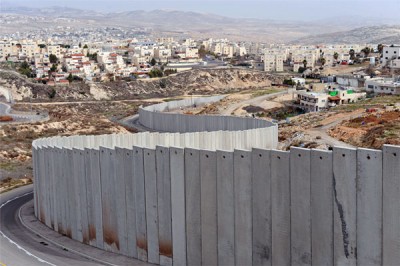Israel’s Illegal Separation Wall Still Standing 10 Years After International Court of Justice Called for Dismantlement

The Separation Wall sits at eight metres tall in places, more than twice the height of the Berlin Wall. In Palestinian cities such as Bethlehem, Qalqilya, and Abu Dis the Wall looms over the local population who have spray-painted words and images alluding to comparisons between apartheid in South Africa and the current situation in the occupied West Bank.
Ten years ago on July 9, the International Court of Justice (ICJ) called for the Wall to be dismantled and labelled it illegal due to the overwhelming economic and social problems it caused for Palestinians. Today the Wall still stands.
Built by Israel under the pretence of security 12 years ago, the barrier was regarded by the ICJ as disproportionate in regards to Israel’s security needs, and a form of collective punishment against the whole Palestinian population in the occupied West Bank.
Snaking through the occupied West Bank, the Wall cuts off villages and people from their own land, and often splits communities in two. Because of the way the Wall weaves in and out, the barrier currently stands at over 700 kilometres long, twice the length of the Green Line, the 1949 ceasefire line that is regarded by many international organisations as the unofficial border between Israel and the occupied West Bank. Eighty-five per cent of the Wall’s route is located within the occupied West Bank.
In Bethlehem, the Wall has severely affected life for many. One Bethlehem family in particular has felt the brunt of the towering structure’s control. The life of the Anastas family was changed drastically when the Wall went up, dividing the Anastas’ from Rachel’s Tomb, which sits directly on the other side of the barrier.
In 2003, two weeks before Christmas, the Wall went up around Claire Anastas’ home within hours.
“They put the Wall around us in one day. I was alone here with my mother-in-law, and we were crying, and we couldn’t do anything,” Anastas said. “Who cares about civilians here? Nobody.”
The house now sits in an enclave of the Wall, surrounded on three sides. Anastas owns a tourist gift shop on the ground floor of the family home, which now gets little to no business. The Wall was built around 10 meters in front of Anastas’ building, and while the building sits on what used to be a busy main road, it has been an abandoned dead end for the past decade. The family are currently in heavy debt due to lack of income.
The Wall has not only affected the Anastas’ income, but also their freedom of movement and everyday life. When the structure went up, some of the Anastas’ family members ended up on the west side of the Wall, cutting them off from family who used to be neighbours. The proximity of the house to the Wall, and the height of the building, has also caused complications. The roof of the Anastas’ house is considered by Israel to be a security threat, and the family must get permission to go onto their own roof. Soldiers frequently occupy her house, using the roof as a vantage point for military operations into the nearby Aida Refugee Camp.
“We are still asking where are the internationals, where are the leaders who work for human rights – they write this title in their organisation’s name,” Anastas said. “Where are they?”
John Dugard, a professor of international law and a former ICJ judge, says even though the ICJ ruled against the barrier, the politics surrounding the United Nations means that their ruling is, in effect, completely impotent.
“The international community lacks the will to enforce opinion. The Security Council, because of the USA, has refused to endorse it. The Quartet has never endorsed it either, and the General Assembly has forgotten about it,” Dugard said. “The Palestinian Authority, under Abbas, is not really interested in invoking international law to support the Palestinian cause, and most states and most people, don’t give a damn.”
The path of the Wall itself annexes historical farmland from small Palestinian communities across the West Bank, in effect granting that land to illegal Israeli settlements that, with the creation of the structure, now lie on the west side of the Wall. Olive groves and other farming fields owned by Palestinian families for generations have been uprooted and seized.
In 2012, the village of Bil’in in the central West Bank managed to convince Israel to have the Wall taken down and moved several hundred metres west. The partial success allowed the village to reclaim a third of its annexed farmland, a victory unique to the village.
Still, much of the village’s land continues to lie on the other side of the Wall, and the village’s weekly Friday protests against the structure are regularly suppressed by the Israeli army through tear gas, rubber bullets and other crowd dispersal means.
“The bulldozer destroyed our land and our trees and took them when they built this Wall,” a member of the Burnat family in Bil’in told MEMO. “And Israel wants me to throw the army flowers.”
While the village’s protests produced an early victory, Burnat said he sees no end in sight for the towering structure that hems his village.
Despite the ICJ ruling 10 years ago, which stipulated the Wall was an illegal structure, it remains in place with no indication from Israel that it will abide by the court’s ruling in the near future. Professor Dugard remains adamant of the Wall’s illegality, and the form of control it is currently a part of.
“The Wall is illegal because it violates norms of international humanitarian law and human rights law. Israel is practicing a form of apartheid in the occupied Palestinian territories. And the Wall emphasises this.”

